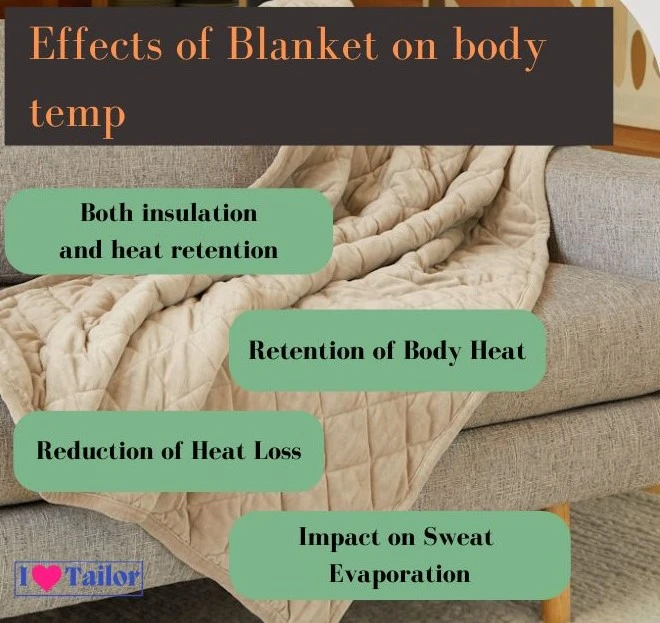How many degrees can a blanket raise body temperature?
Blankets are not just cozy accessories that provide warmth and comfort; they also have a significant impact on our body temperature. We may choose wisely how to use blankets and maximize our comfort by being aware of how they affect body temperature. In this post, “How many degrees can a blanket raise body temperature?” We’ll go into the intriguing topic of blankets and body temperature, as well as the science of thermoregulation and the different ways that blankets can affect our body temperatures. Let’s explore the mysteries of blankets and how they affect our body temperatures.
The Science of Temperature Regulation in the Human Body
Let’s quickly review how our bodies control heat before we examine how blankets affect body temperature. Through a process known as thermoregulation, our bodies work to maintain an ideal internal temperature of about 98.6°F (37°C). This intricate mechanism keeps our bodies within a specific temperature range by coordinating several physiological reactions.
What Effect Do Blankets Have on Body Temperature?

Both insulation and heat retention
The insulation and heat-trapping properties of blankets are among the main ways they influence body temperature. A layer of insulation is created between our bodies and the environment when we cover ourselves with a blanket. By stopping the loss of body heat, this insulation keeps us warm and cozy. The blanket’s insulating qualities are greatly influenced by the material and thickness of the blanket. While lighter textiles might offer less insulation, materials with better insulating properties include fleece and wool. The blanket’s capacity to trap air is also influenced by its thickness, which has an impact on how well it insulates.
Retention of Body Heat
Blankets not only prevent the loss of body heat but also help retain the heat our bodies generate. When covered with a blanket, the heat radiating from our bodies gets trapped within the enclosed space. This trapped heat warms the air around us and keeps us snug. Retaining body heat is especially beneficial in colder environments or during sleep when our body’s metabolic rate naturally decreases. By retaining the heat generated by our bodies, blankets help maintain a comfortable temperature and prevent excessive cooling.
Reduction of Heat Loss
Apart from insulation and heat retention, blankets also reduce heat loss through various mechanisms. Heat can be lost from our bodies through radiation, convection, and conduction. Blankets act as a barrier, minimizing the transfer of heat through these processes. Radiant heat loss occurs when our bodies emit heat energy that is absorbed by cooler surfaces. Blankets, with their insulating properties, reduce this transfer of heat, helping us maintain a higher body temperature.
Convection is the transfer of heat through the movement of air or fluids. When we are covered with a blanket, it forms a barrier that restricts the movement of air, reducing convective heat loss. Conduction is the transfer of heat through direct contact between objects. When we touch a cold surface, heat is transferred from our bodies to the object. Blankets provide a layer of insulation that minimizes the contact between our bodies and colder surfaces, reducing heat loss through conduction.
Impact on Sweat Evaporation
Sweat evaporation is a natural cooling mechanism of our bodies. When we sweat, the moisture on our skin evaporates, taking away heat and cooling us down. Blankets can hinder this evaporation process by trapping moisture close to our bodies.
When sweat evaporates less efficiently due to the presence of a blanket, it can lead to a potential rise in body temperature. This effect is particularly noticeable in warmer environments or when using heavy blankets that restrict air circulation.
Factors Influencing Blanket’s Effect on Body Temperature

Several factors contribute to how much a blanket can raise body temperature:
Material and Fabric Type
The type of material and fabric used in a blanket plays a significant role in its impact on body temperature. Different materials have varying insulation properties. Natural fibers like wool and down are known for their excellent insulation capabilities, while synthetic materials like fleece offer warmth without excessive weight.
Related post: Velvet suit stitching designs
Blanket Thickness and Weight
The thickness and weight of a blanket also influence its effect on body temperature. Thicker and heavier blankets generally provide greater insulation, but they may be too warm for certain individuals or in warmer climates. Lighter blankets can still provide comfort without causing overheating.
Ambient Temperature and Humidity
The surrounding environment greatly affects how blankets influence body temperature. In colder climates, blankets play a crucial role in keeping us warm, while in hotter regions, they might be used more sparingly to prevent overheating. The humidity levels in the environment can also impact how effectively sweat evaporates and affects body temperature.
Individual Factors
Each person has unique body characteristics and preferences. Factors such as metabolic rate, sensitivity to temperature, and personal comfort levels can affect how a blanket affects body temperature. It is essential to pay attention to individual needs and adjust blanket usage accordingly.
How Blankets Can Raise Body Temperature?
let’s explore how blankets can raise body temperature:
- Enhancing Thermoregulation: Blankets provide a conducive environment for effective thermoregulation. By providing insulation and preventing excessive heat loss, blankets can help raise body temperature and maintain a comfortable balance.
- Promoting Relaxation and Comfort: The warmth and coziness offered by blankets have a psychological impact, promoting relaxation and comfort. When we feel relaxed, our bodies can maintain a steady temperature more efficiently.
- Providing a Sense of Security: Blankets offer more than just physical warmth; they provide a sense of security and familiarity. This emotional comfort can contribute to a more relaxed state, indirectly influencing body temperature regulation.
Potential Risks and Considerations
While blankets offer numerous benefits, it’s essential to be aware of potential risks and consider individual factors:
- Overheating and Hyperthermia: Using overly thick or heavy blankets in warmer environments or overheating a room can lead to excessive body heat retention, potentially causing discomfort, dehydration, and even hyperthermia. Choose blankets wisely to prevent overheating.
- Individual Sensitivity and Preferences: Each person has unique sensitivities to temperature. Pay attention to your body’s signals and adjust blanket usage accordingly to ensure optimal comfort.
- Special Considerations for Infants, Elderly, and Ill Individuals: Babies, older adults, and individuals with certain health conditions might have specific temperature requirements. Consult healthcare professionals for tailored advice on blanket usage for these groups.
Can staying under a blanket cause a fever?
No, staying under a blanket alone does not cause a fever. Fevers are typically a result of underlying illnesses or infections, not the use of a blanket. However, it’s important to avoid overheating by using blankets that provide enough warmth without excessive sweating.
Remember to maintain a comfortable room temperature and ensure proper airflow. If you have a persistent high body temperature, it’s best to consult a healthcare professional to determine the underlying cause.
FAQs
Can using a blanket raise my body temperature excessively
Excessive use of thick or heavy blankets, particularly in warmer environments, can lead to overheating. It’s essential to choose blankets wisely and pay attention to your body’s signals to prevent discomfort or overheating.
Can blankets affect my sleep quality?
Blankets play a crucial role in promoting relaxation and comfort, which can positively impact sleep quality. However, individual preferences vary, and it’s important to find the right balance of warmth and comfort for a restful sleep.
Can using too many blankets lead to dehydration?
Excessive sweating caused by using too many blankets can contribute to dehydration. It’s important to maintain proper hydration by drinking an adequate amount of water, especially when using blankets that hinder sweat evaporation.
Conclusion: degrees can a blanket raise body temperature
Blankets are more than just cozy companions; they play a vital role in regulating our body temperature. Understanding, “How many degrees can a blanket raise body temperature?” and how blankets impact our internal heat levels helps us make informed decisions about choosing the right blankets and using them effectively.
It’s important to avoid overheating by using blankets wisely, especially in warm environments. Pay attention to your body’s signals and make adjustments accordingly. Blankets provide physical comfort and contribute to relaxation and a sense of security. So, wrap yourself in your favorite blanket, experience the warmth, and enjoy the benefits it brings to your body and mind.
Thanks!







